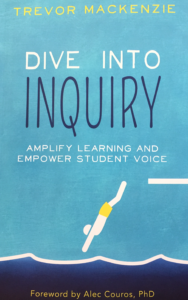 High school English teacher Trevor Mackenzie’s recently published book by EdTechTeam Press, Dive Into Inquiry: Amplify Learning and Empower Student Voice, presents an approach to personalized learning requiring students to eventually take ownership of their own learning.
High school English teacher Trevor Mackenzie’s recently published book by EdTechTeam Press, Dive Into Inquiry: Amplify Learning and Empower Student Voice, presents an approach to personalized learning requiring students to eventually take ownership of their own learning.
A tough student situation sparked his own dive into inquiry. Mackenzie sought ways to retain students who might otherwise seek alternative classes or drop out altogether. His seven year journey culminated in the publishing of this book.
Dive Into Inquiry has a broad scope, and isn’t a narrow lesson, unit, or experience. It is a fundamental, yet doable shift that requires educators to keep in mind:
- a mindful transition to foster student agency and support the shift in pedagogical models students will experience
- a collaborative journey through the Types of Student Inquiry that nurtures a gradual release of control over learning in the classroom
- gaining a grasp of Understanding by Design and planning for a performance task that demonstrates deep understanding
- honouring our students, their passions, and goals and tying them to the learning objectives of the course (quoted from the introduction, bold mine)
This easy to read book (about 130 pages) outlines shifts in pedagogy, types of student inquiry, essential questions, creating an authentic product and displaying it publicly. He starts with some classroom management strategies, such as being flexible, teaching real skills, making eye contact with students, and taking the time to get to know them.
Inquiry based learning is not about telling students to find something that they want to learn about and go do it. Inquiry based classrooms aren’t about the teacher sitting in the back of the room checking email and correcting spelling and grammar. This approach is about scaffolding students’ journey into learning about something that they care about and guiding this trip by assisting students in developing a free inquiry proposal and providing prompts.
Sprinkled throughout the pages are QR codes that link to YouTube videos of student work, some his own and some from across the globe. These students have produced work and broadcast it to the world. Video evidence is one way students demonstrate their learning, as well as writing, video/audio, photography, and dance. His learners record evidence of their learning with storyboards, compilation of resources, their learning process, photography, feedback from mentors or critics.
Mackenzie recommends starting small, but with a plan. You can start by revising an existing unit of study, designing a syllabus with your students, or infusing a smaller chunk of learning with the Dive Into Inquiry process, which scaffolds each step into the next. Plan, do, iterate, and reflect.
#diveintoinquiry
(I was not paid to write this review, nor was I given the book to review it. I did receive it for no cost as a prize in a recent Teacher Appreciation promotion by EdTechTeam and thought it was very worth reading and reviewing.)
